🌱 AP Environmental Science Unit 9 Notes
15-20% of the AP Exam
Topics
9.1 Stratospheric Ozone Depletion
9.2 Reducing Ozone Depletion
9.3 The Greenhouse Effect
9.4 Increases in the Greenhouse Gases
9.5 Global Climate Change
9.6 Ocean Warming
9.7 Ocean Acidification
9.8 Invasive Species
9.9 Endangered Species
9.10 Human Impact
These notes are based on Mr Jordan Dischinger-Smedes’s YouTube videos and the fill in template notes for these videos created by Carolyn Kelleher Mendonca. Some changes were made. Videos available here.
Good luck on the AP Test! 🩷
9.1-9.2 Stratospheric Ozone Depletion & Reducing Ozone Depletion
Stratospheric Ozone & Life on Earth
Ozone in the stratosphere absorbs UV-C and much of UV-B radiation, which are harmful.
Without ozone layer, life on land would not be possible since UV-B & C radiation cause significant tissue damage and mutates DNA,
Human health benefits of stratospheric ozone:
Prevents skin cancer and cataracts
UV-B and C mutation DNA and cause oxidative stress in eyes
Remember: Tropospheric Ozone is a respiratory irritant, damaging to plant tissue & precursor to photochemical smog
How Ozone Absorbs UV-B & UV-C
UV-C breaks O2 into free O2
When a free oxygen atom from this reaction binds with an oxygen O2 molecule, ozone (O3) is formed
UV-C also reverses the run by breaking O3 into O and O2, which can then bond with another free O to form O2
Continued formation & breakdown of O3 in the stratosphere absorbs all UV-C & much UV-B radiation (protecting organisms on earth)
Anthropogenic Ozone Depletion
CFCs are a primary anthropogenic (human) cause of O3 breakdown
Used as refrigerant chemicals and propellants in aerosol containers (hair spray, febreeze, etc.)
UV radiation causes free chlorine atom to separate from CFCs
Highly electroneg. chlorine atom bonds to One oxygen atoms of ozone (O3) converting it into oxygen (O2)
Free O atom then bonds to O from chlorine monoxide to form O2 and free Cl atom to go break down more O3
One single Cl atom persists in the atmosphere for 50-100 years and can destroy 100,000 O3 molecules
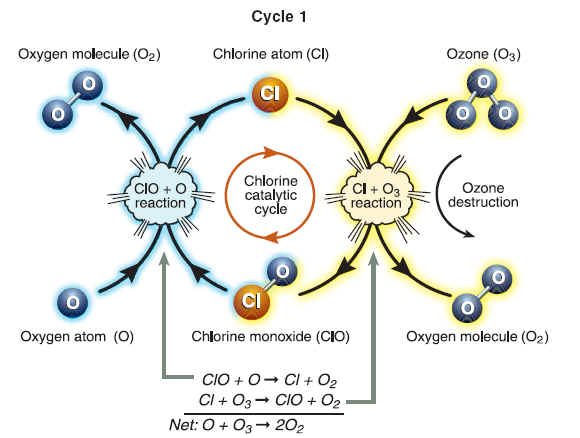
Natural Ozone Depletion
Antarctica spring melt forms polar stratospheric clouds (PSC)
Clouds made of water and nitric acids (HNO3) that can only form in consistent -100 F temp. range found above antarctica
In presence of PSCs, chlorine nitrate (ClONO2) and hydrochloric acid (HCl) react & give off Cl2
Cl2 (broken by sun) into 2 free Cl atoms
Remember what Cl atoms due to ozone from CFCs (break down O3)
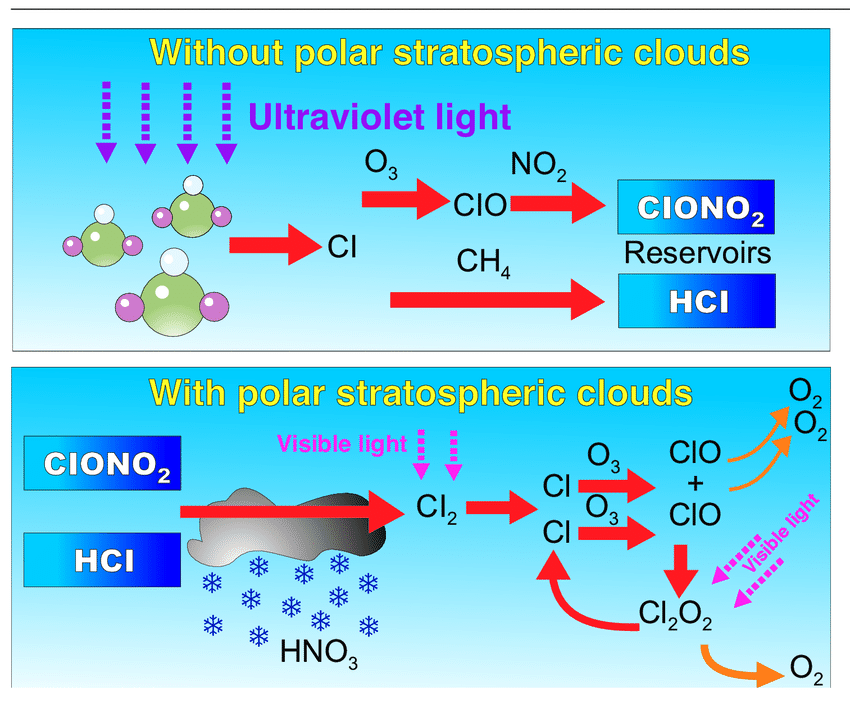
9.2 - Reducing Ozone Depletion
The main way to reduce anthropogenic O3 depletion is phasing out and replacing CFCs.
Montreal Protocol (87’) was a global agreement to phase out CFCs in refrigerators, aerosols and other uses
Replaced with HCFCs (CFCs with hydrogen added)
HCFCs still delete O3 and act as GHG, but to a lesser degree than CFCs
Not a permanent solution, but a temporary transition option (phase out in dev. Nations after 2020, developing nations have until 2030)
**Replacement for HCFC is HFC (still GHG, but does not deplete O3 since they don’t contain Cl)
**Replacements for HFCs are HFOs (just HFCs with C-C double bonds that shorten atmosphere lifetime & GWP)
9.3 The Greenhouse Effect
Solar Radiation
Not all incoming solar radiation reaches earth’s surface
26% reflected back into space by clouds & atm.
19% absorbed by atm. & clouds & radiated
out into space & down to earth
The rest reaches earth’s surface where it can be absorbed or reflected (depending on the albedo of the surface it strikes)
Darker, lower albedo surfaces absorb sunlight & release infrared radiation (which we feel as warmth)
Lighter, higher albedo surfaces reflect sunlight, directly back out into space, or into clouds/GHGs that absorb it
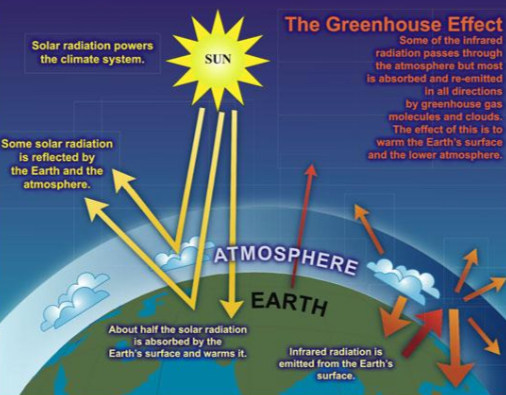
The Greenhouse Effect
Gasses in earth’s atmosphere trap heat from the sun & radiate it back down to earth. Without the greenhouse effect, earth would be too cold to support life.
How it works:
Solar radiation (light waves like UV & visible light) strike earth’s surface, heating it
Earth’s surface releases infrared radiation (heat)
Greenhouse gasses absorb infrared radiation & radiate it both out into space and back toward earth
The portion of infrared radiation (heat) coming back to earth is the “greenhouse effect”
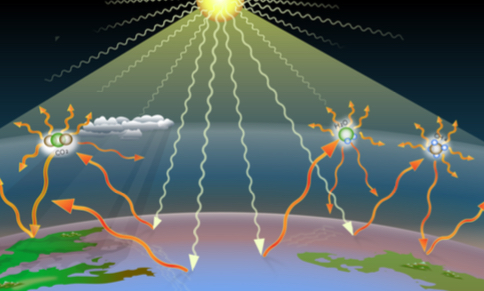
Greenhouse Gasses & Sources
Most important Greenhouse Gases (GHGs) are:
CO2 - FF combustion, decomposition, deforestation
Methane (CH4) - natural gas extraction & combustion, animal agriculture, anaerobic decomp. (especially permafrost thaw)
Nitrous oxide (N2O) - agricultural soils (denitrification of nitrate, especially in overwatered, over fertilized soils)
CFCs/HCFCs/HFCs - refrigerants, blowing agents in aerosol products
*Water vapor (H2O) - evaporation & transpiration from plants
*Technically a GHG by definition, but doesn’t drive atm. temp change (other way around - temp. Controls atm. H2O vapor level)
Global Warming Potential (GWP)
Based on 2 factors:
1) Residence time: how long molecule stays in the atmosphere
2) Infrared absorption: how well the gas absorbs & radiates Infrared radiation (IR) CO has a GWP of 1 (all other gasses are measured in relation to CO )
Methane (CH4) remains in atmosphere around 12 yrs, absorbs more IR than CO2, and GWP = 23-84
N2O remains in atmosphere around 115 yrs, absorbs much more IR than CO2, and GWP = 300
CFCs remain in atmosphere 50-500 yrs, absorb much, much, much more IR than CO2, and GWP = 1600-13000
9.4 Increase in Greenhouse Gasses
Thermal Expansion
Water molecules move slightly further apart when they’re heated
All the water molecules of ocean moving slightly apart leads to sea level rising
This water flows into the ocean and leads to sea level rise
Melting Polar & Glacial Ice
Increased greenhouse gasses lead to a warmer climate & more melting of ice sheets (at the poles and glaciers)
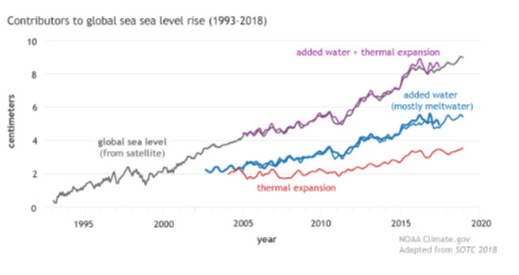
Environmental Impacts of Sea Level Rise
🏔 Flooding of coastal ecosystems like estuaries (mangroves, salt marshes)
Loss of species that depend on arctic and tundra ecosystems (polar bears, penguins, reindeer)
Loss of thaw-freeze cycle that glaciers go through, depriving surrounding ecosystems and human communities of water source
Human Impacts
🏔 Relocation of coastal human populations
Increase in flood frequency causes higher insurance and repair costs, lost property
Saltwater intrusion (salt water pushing into ground water & contaminating wells)
Refugees forced to move inland
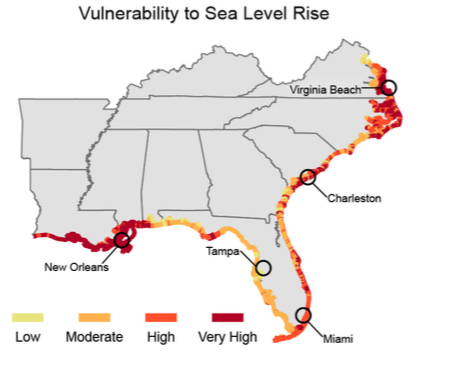
Disease Vectors
Expanded Range
Living organisms (usually mosquitoes, ticks, fleas) that can transmit diseases from human to human or animal to human
Vectors
Ex: malaria, Zika, West Nile, dengue fever, cholera
Warmer temperatures allow insect-transmitted diseases to spread to parts of the world previously too cold
As the insect vectors expand their range further from equators, toward poles, new human populations are at risk
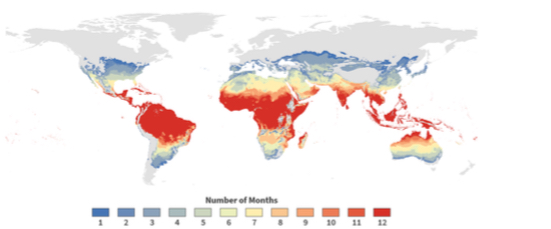
9.5 Global Climate Change
Historic Climate Change
⛰ Earth’s climate has varied over geologic time, largely due to variations in earth’s orbit around the sun
Varies in obliquity (~40,000 yrs.) exposing northern latitudes to higher insolation at different times
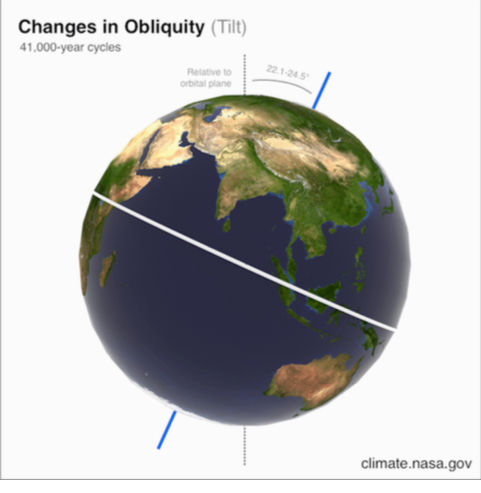
Varies in eccentricity (~100,000 yrs.) bringing it closer to and further from the sun at different times
More eccentric = further from sun
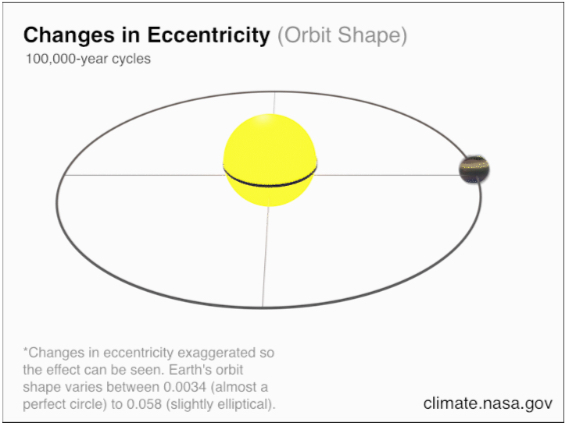
Changes in eccentricity led to predictable variation in Earth’s climate called Milankovitch Cycles
Earth’s Historical Climate
Scientists have measured and estimated earth’s historical temperature and CO2 levels using 3 main pieces of evidence
Foraminifera shells in ocean sediments - different species have different temperature tolerance, so viewing the species present at a certain time can show what the temperature was.
Air bubbles in ice cores that contain ancient atmospheric gas (CO2 levels)
¹⁶O vs. ¹⁸O isotope concentrations in ancient ice ( ⬆ ¹⁸O = ⬆ temperature)
Global ice ages, followed by warmer periods occur roughly every 100,000 years CO2 levels are strongly correlated with temperature, but causality isn’t fully understood
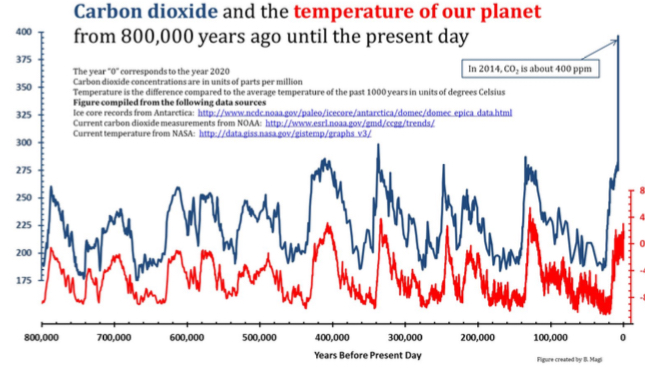
Effects of Climate Change
Rising Temperature - habitat/species loss, drought, soil desiccation, heat waves, increased precipitation in some regions
Rising Sea Level - due to glacial (polar) ice melt and thermal expansion
Melting of Permafrost - permanently frozen tundra soils that begin to thaw & release methane & CO2 from anaerobic decomposition, causing a positive feedback loop.
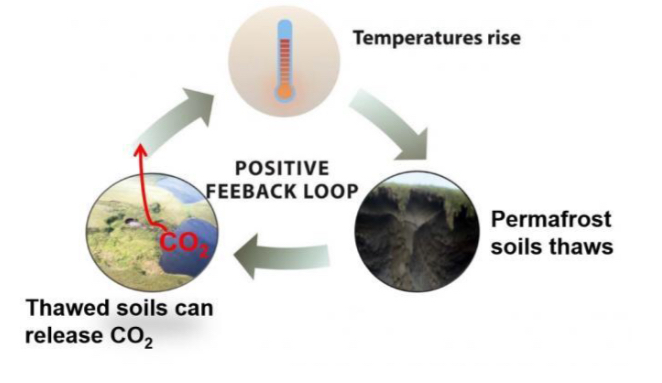
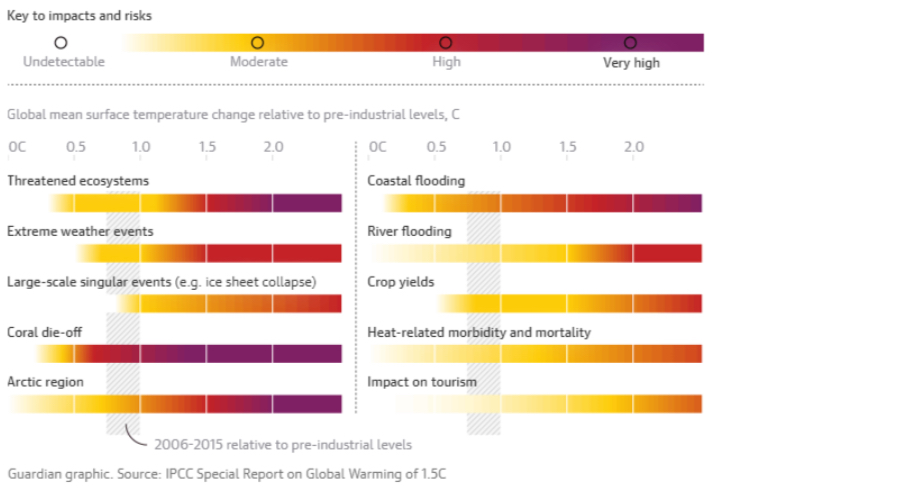
Impact on Coastal Communities
Property loss, damage, potential relocation:
Coastal communities, especially poorer ones that can’t build up may need to relocate inland
Seawalls or other barriers can be built higher, but this just delays eventual flooding
Loss of barrier islands: islands that buffer coastal communities/ecosystems from wind & waves may be lost as sea level rises
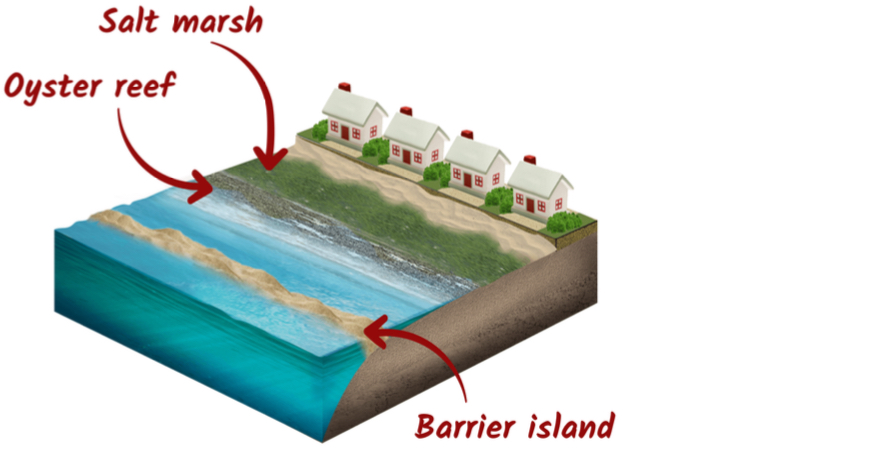
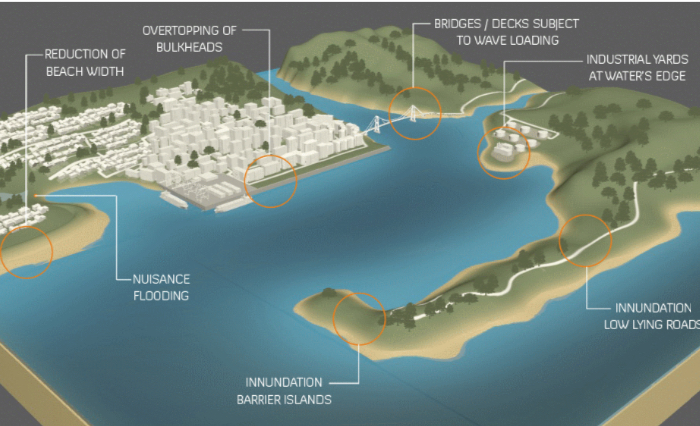
Impact on Atmospheric Currents
Widening & weakening of hadley cell: as temp. diff. between equator and poles decreases, air ascending and expanding from equator travels further before sinking
This shifts subtropical zones (dry, desert biomes) toward the poles and expands the tropics
Regions between 300 and 60o may experience drier climate as cool, dry, descending air from hadley cell shifts north & south
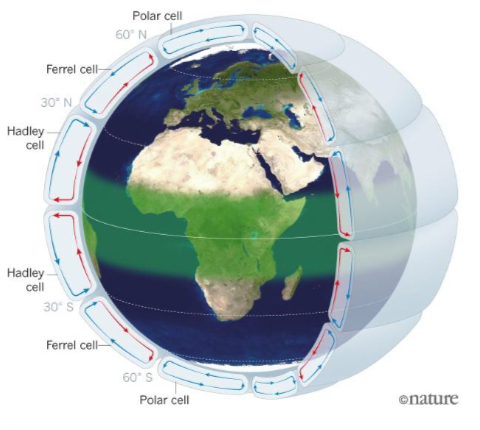
Weakened, destabilized Jet Stream
As the arctic warms faster than other areas of earth, temperature differences between equator & poles decreases
Because temperature & pressure different between polar & subtropical regions is what drives the polar jet stream, less different between them means weaker, wobblier jet stream
Leads to extreme cold spells in eastern US & dry spells in western US
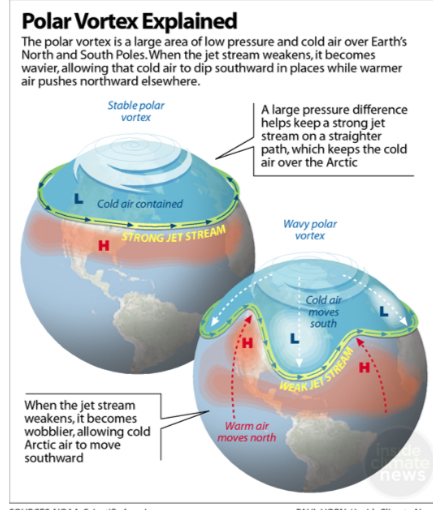
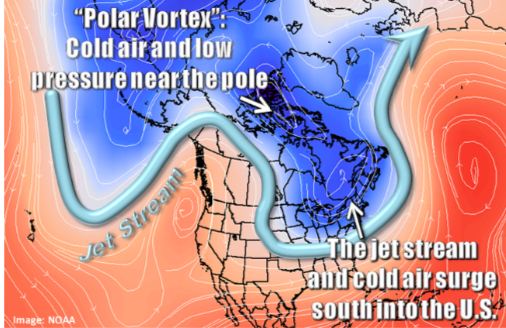
Impact on Marine Ecosystems
Altered range of marine ecosystems: some new marine habitats will be formed by rising sea level flooding coastline
Some areas of ocean will become too deep to receive sunlight & photic zone will shift up, further from ocean floor
Altered ranges for organisms: warm water holds less O2, so many fish populations decline or migrate to cooler waters
Impact on Ocean Circulation
Suppression of thermohaline circulation: global ocean current that redistributes heat from the equator, salt, and nutrients by mixing ocean waters could slow or stop altogether
Ice melt from Greenland ➡ especially cold, fresh water buildup in north atlantic
Freshwater is less dense than salt, preventing it from sinking
This cold north atlantic slows warmer Gulf Stream waters, cooling Europe & slowing global thermohaline circulation
Unequal Global Warming
Polar regions of earth are warming faster than other regions (polar amplification)
Especially the arctic (N pole) because there is more land & less water to absorb heat
Melting sea ice = more exposed ocean water, which absorbs more sunlight than ice & snow, leading to more ice melting (positive feedback loop)
Distribution of tropical heat to poles by thermohaline circulation also warms poles
Unequal Global Warming
Melting of Permafrost - permanently frozen tundra soils that begin to thaw & release methane & CO2 from anaerobic decomposition
CH4
Air pollution adds soot & other PM to atmosphere, distributed to poles by atmospheric circulation
Darker, soot/PM covered ice absorbs even more heat due to lower albedo
Impact on Polar Ecosystems
Arctic sea ice loss = habitat loss
Seals use it for resting and find holes for breathing
Algae grow on ice, forming base of arctic food web
Polar bears use ice for hunting seals at breathing holes
9.6 - Ocean Warming
Atmospheric Warming ⬅➡ Ocean Warming
As the atmosphere warms, heat is transferred to the ocean
Ocean absorbs heat radiated back to earth by greenhouse gasses
Oceans absorb much of earth’s heat due to high specific heat of water (est. 90% of earth’s warming from the past 50 yrs. occured in oceans)
Thermohaline circ. distributes heat absorbed at surface to depths & other areas of earth
Heat absorbed by ocean can transfer back to atmosphere for decades
Effects on Marine Species
🏔 Warmer water holds less O2; causing resp. stress or suffocation
Migratory routes and mating seasons can be altered, especially for whales
Reproductive timing, often tied to temp. change, can be disrupted (fish esp.)
Habitat loss: coral bleaching with heating ocean; shallow, sunny waters ideal for algae & coral become deeper from ice melt
Toxic algae blooms: toxic blue-green algae prefer farmer waters & farm temperature prevents mixing of water, enabling algae blooms
Blue-green algae release toxins into the water that can kill marine species
Can also block sunlight & lead to hypoxia
Coral Bleaching
🏔 Coral reef = mutualistic relationship between coral & photosynthetic algae called zooxanthellae; algae supply sugar & coral supply CO2 + detritus (nutrient containing org. matter.)
Algae have narrow temp. tolerance and leave the reef when temp. rises
Pollutants from runoff (sediment, pesticides, sunscreen) can also force algae from reef
Coral lose color & become stressed and vulnerable to disease without algae (main food source)
9.7 - Ocean Acidification
Increased CO2 in atmosphere causes increased ocean CO2 (direct exchange)
CO2 combines with ocean water to form carbonic acid (H2CO3)
Carbonic acid dissociates into Bicarbonate ion (HCO3-) and H+ ion
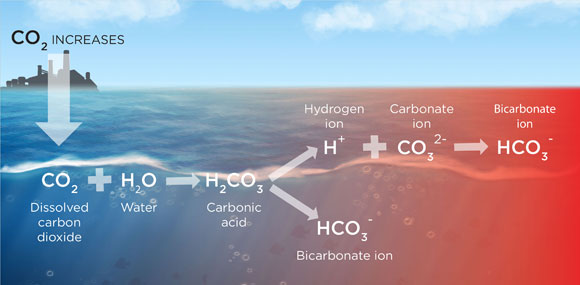
Marine org. that make shells use calcium (Ca+) and carbonate (CO32-) ions to build their calcium carbonate shells (calcification)
CO2 increase & ocean acidification makes carbonate ions less available
Carbonic acid ➡ increased H+ ions which bond with carbonate to form Bicarbonate (HCO3-)
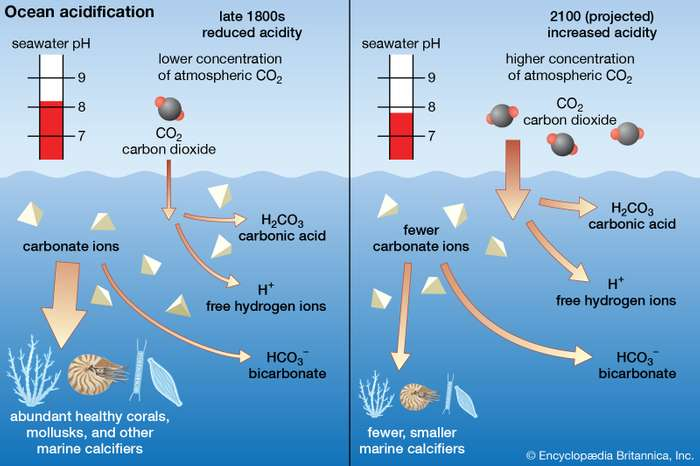
Marine shells breakdown as pH decreases and carbonate ions are less soluble in ocean water
Fewer carbonate ions = less calcification; eaker shells of coral, mollusks, and urchins
Anthropogenic causes for ocean acidification: fossil fuel combustion (CO2), deforestation (CO2), and coal/gas combustion (NOx/SOx → acid precip.)
CO2 increase directly correlated with ocean acidification
Inverse relationship between atm. CO2 & ocean pH (low pH = more acidic)
Ocean pH has decreased from 8.2 to 8.1 in past 150 years; could decrease to 7.8 by 2100
*pH = log scale so 8.2 to 8.1 = 30% decrease
9.8 Invasive Species
Invasive Species Basics
Species not native to an area, introduced often by human transport
No natural predators to control pop.
Highly competitive (aggressive feeders or fast growers) for resources
Can thrive in their non-native habitats
r-selected, generalists
R-selected and generalist species are more likely to be invasive
High biotic potential & low parental care
Highly adaptable
Diverse habitat & food needs
Invasive Species To Know
Zebra Mussel
Transported by ship ballast water
Aggressive filter feeders, eating algae many other species rely on
1 mil. eggs/yr.
Clog intake pipes
Kudzu Vine
Planted to limit soil erosion in southern US
Grows very rapidly
Outcompetes natives for sunlight; growing over them
No herbivore control in US
Asian Carp
Brought in to control algae growth in aquatic farms
Escaped to Mississippi river; outcompete native fish for food and space
Decreases fishery production & value
Emerald Ash Borer
Spread by wood packing materials of ships/planes & fire wood
Larvae laid in bark, eat their way into phloem
Disrupts tree nutrient transport, killing them
Expanding range due to global warming
Cane Toad
Introduced to eat cane beetles causing sugarcane crop loss in Australia
Became invasive due to huge appetite
Drove declines in other amphibians and small reptiles
Pythons (FL)
Brought to Florida as pets, released into wild by owners
Decimated mammal populations in Everglades ~90-95%
Aggressive hunters with no natural predators
Controlling Invasives
🏔 Invasives estimated to cost US $120 billion/year (2005 est.)
Lost agr. productivity, tourism, property value decline, fishery decline, control and removal costs
Control/Removal Methods
Laws preventing transport of invasives (firewood for emerald ash borer) ○ Removal of hosts (dead ash trees for EAB) to reduce spread
Careful boat cleaning & inspection (zebra mussels)
Introduction of natural predator (biological control)
Chinese wasps to kill emerald ash borer
Physical removal (hunting pythons, detaching z. mussels, pulling plants out, cutting trees down)
9.9 - Endangered Species
How Species Become Endangered
Poaching
Poachers hunt exotic species for fur, tusks, horns
May also be over harvested or hunted for food
Removed from wild & sold as pets
Special food/habitat needs
Niche specialists are more prone to endangerment due to specific food/habitat needs
Invasives
Invasives can outcompete natives for resources (food, water, sun, space)
Zebra mussels have endangered 30 native mussel species in US rivers
Climate Change
Shifts habitats of many species
Migration to new habitat is harder with fragmentation/loss
Less tolerant of changing climate, habitat loss, wildfires, deforestation, urbanization, etc.
Changes in temp/precip. can occur too rapidly for some species to migrate or adapt
Protecting Endangered Species
Poaching Prevention
Hiring of armed guards to monitor populations and prevent poaching
Laws that punish poaching severely, with stiff fines or jail time
Legislation
⛰ CITES: International agreement for countries to set up agencies to monitor import and export of endangered species (as specified by IUCN Red List)
⛰ Endangered Species Act: US law giving USFWS power to designate species as endangered or threatened, monitor trade, and purchase land critical to these species’ habitats
Protect Wildlife Habitats
Designating areas with important habitats as:
National parks
Wildlife preserves
Animal sanctuaries
Prevention of hunting, development, fragmentation, deforestation
Allows species to breed and reestablish population size
IUCN Red List
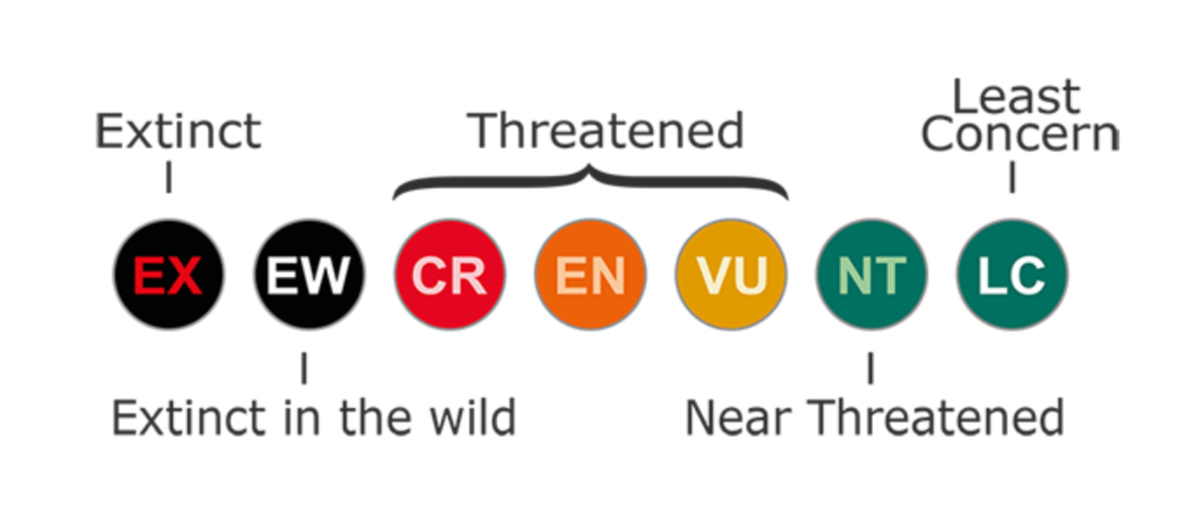
Endangerment by Taxon
Amphibians -
Especially vulnerable to climate change due to biphasic life (relying on water and land) and highly permeable skin
Warm Water Coral -
Threatened by changing ocean temperature and pH (ocean acidification from increasing atm. CO2 levels)
Conifers -
Threatened by disease and warming temperatures expanding insect pest ranges
Coniferous forests sequester 3X as much CO2 as temperate or tropical forests
Specialists vs. Generalists
Specialists
More likely to be endangered or become extinct
Less likely to move to new habitat
Less likely to adapt to new conditions
Disadvantaged by rapidly changing habitat conditions
Generalists
Less likely to become endangered or extinct
Advantaged by rapidly changing habitat conditions
More likely to move to new habitat
More likely to adapt to new conditions
Competition & Endangerment
Shenandoah salamander: endangered species, limited to ranges on specific mountains due to fiercely territorial red-backed salamander
- VS
Red-backed Salamander: Classified as “least concern” by IUCN. Guards rock habitats from other salamander species, preventing range expansion
Interspecific competition: competition for resources (food, nest sites, water)
amongst members of different species
Can cause species to become threatened, especially when combined with general habitat fragmentation or loss due to human land use
Can further threaten species already vulnerable to habitat disruption due to climate change
9.10 - Humans Threats to Biodiversity
HIPPCO
Habitat Fragmentation/Loss
Deforestation (lumber, cities, roads), wetland draining (ag, urbanization), river water level decreased by dams.
Invasive Species
Invasives such as z. mussel and kudzu vine outcompete native species for food/space, lowering populations
Population Growth
Human pop. growth drives hab. loss Urbanization, ag. expansion to feed more people remove/fragment hab.
Pollution (Pollutants)
Oil spills reduce marine org. pop. sizes Pesticides (glyphosate, atrazine) kill non-target species
Climate Change
Shifts biomes & therefore species habitat ranges, can change temp. & precip. patterns too rapidly for a species to adapt or migrate, causing pop. decline or extinction
Overexploitation
Excessive hunting or poaching (faster than reproductive rate) leads to pop. decline & potential extinction
Roads & Pipelines
Roads & oil/gas pipelines fragment habitats; disrupt movement & lead to fatal collisions with vehicles
Agricultural & Urban Land Use
Clearing forest/grassland for ag. fields or urbanization fragments those habitats.
Logging
Both removal of trees & construction of logging roads to transport lumber fragment forest ecosystems
Metapopulations
🏔 Some species are more disrupted by fragmentation than others
Large predators needing large hunting space
Smaller populations of large k-selected mammals may struggle to find mates
🏔 Habitat Fragmentation creates smaller, isolated subpopulations
Smaller subpopulations have less genetic diversity, are more prone to inbreeding depression, and are less resilient to env. disturbance or disease
Metapopulations are mostly isolated, subpopulations connected by habitat corridors; this can allow some gene flow (mating between populations) and improve genetic diversity
Edge Effect
“Edge habitat” where two ecosystems such as forest-grassland or ocean-river (estuaries) meet have diff. characteristics than the middle of each ecosystem
Some species thrive in the edge habitat & biodiversity is often higher in edge habitats due to diversity of food, shelter, and nutrient resources
Edge habitats can expand range of potentially disruptive species (ex: brown headed cowbird) that thrive in grassland-forest edge
Brood parasite that leaves its eggs in the nests of songbirds for them to raise, unknowingly
Climate Change
Temperature change
Climate change can shift the range of habitats, or increase/decrease their range altogether
Warming temp. can shift biomes
Boreal forest & temperate coniferous forests may shift northward; tundra may decrease
Precipitation change
Warming global. temp. will decrease precipitation in some areas, leading to soil desiccation and desertification
Will increase in some areas, expanding tropical ecosystems
Sea level rise
Estuary habitats (salt marshes, mangroves) become fully submerged & more saline; coastal ecosystems become flooded
Biodiversity & Domestication
Domestication of species for agriculture generally decreases genetic and species biodiversity Crops
Fewer plant species are grown as selective breeding and GM results in only the highest yield species
GM use and selective breeding also lead to less genetic diversity in crops, making them more vulnerable to disease or environmental disruptions
Livestock
Historically, there have been over 8,000 breeds of the 11 species most commonly eaten by humans
Breeds were uniquely adapted to local climate - Many breeds are now extinct, or at risk due to selection for only highest productivity
Mitigating Biodiversity Loss
Protecting & Connecting Habitats
Protecting important habitats by creating national parks, nature preserves, or preventing them from being developed
Connecting fragmented habitats with wildlife corridors enables movement/breeding
Sustainable Land Use
Urban growth boundaries, infill, and building up (not out) to reduce urban sprawl can preserve existing habitats
Expanding parks, urban gardens, green roofs can provide habitat for many species
Sustainable agriculture, lowering meat consumption can reduce ag. land needs, preventing hab. loss
Restoring Lost Habitats
Replanting clear-cut forests
Reestablishing prairies on old ag. fields or golf courses